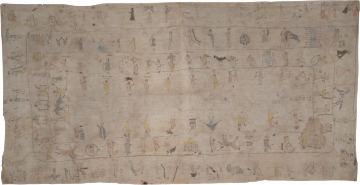1837–38: Smallpox decimates tribes; survivors join together
A smallpox epidemic destroys the Numakiki (Mandan) Indians in North Dakota. Although they experienced a smallpox epidemic in 1837, the one in 1838 is so severe that only 130 out of 10,000 people survive. The Numakiki join with other survivors among the Sahnish (Arikara) and Minitari (Hidatsa) peoples.
Today the three are known as the Mandan, Hidatsa, and Arikara Nation or the Three Affiliated Tribes.
- Theme
- Epidemics
- Region
- Great Plains
The Lakota marked the passage of time by drawing pictures of memorable events on calendars called winter counts. This picture, titled “Small Pox Winter,” is for 1837–1838 and is from a winter count named the Rosebud winter count. Winter counts were physical records used in conjunction with oral history. The events used to name the years were not necessarily the most important things that happened, but ones that were memorable and widely known within the Lakota community.
It is not known who made this winter count or where. It is named the Rosebud winter count because it belonged to the family of John Anderson, a photographer who worked on the Rosebud Reservation between 1880 and 1935.
Courtesy National Anthropological Archives, Smithsonian Institution
